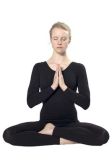
By Dr. Paul Jerard, E-RYT 500
Always remember that it is better to be accused of being too cautious, than it is to be accused of negligence within a court of law. The Yoga teacher who is too safe can always find another teaching assignment. Below are some common problems that Yoga teachers should address for the safety of their students.
Spinal Rock: The eyes should focus on your heels, or navel, if possible. This causes the whole spine to round off and “roll like a ball,” as opposed to “crashing” off the floor. Rolling back should only go to the shoulders. Some Yoga students will be injured if they are not cautioned about rolling back on their necks.
During your Sun Salutation, or Vinyasa Sequence, where you perform a Monkey posture, which is also known as, “Flat Back,” the body should take the shape of an inverted “L.” The best way to master this posture is to draw, and elongate your spine, in a straight line, parallel to the floor. A mirror, or knowledgeable Yoga teacher, would be a big help for developing alignment.
You should caution your students about the jump backs on Sun Salutations, or Vinyasa Sequences. Anyone with a back condition can make it worse with the jump back or the jump forward; the reason being that when your feet land on the floor, the shock of the movement goes into the lower spine.
A similar movement we know as the “squat thrust” was contra-indicated by the American Orthopedic Association, a few years ago. This movement is the same as the squat thrusts. Many Yoga teachers are very familiar with this movement from Ashtanga and Vinyasa styles, however, beware that each student is put at risk – no matter how good their back feels today.
In Warrior I, please make sure that your Yoga student’s back foot is turned in 45 degrees.
When the hip rotates forward, in the direction of the forward foot, this puts torque on the back knee. If a student has the back foot out at 90 degrees, this is a great deal of torque, and can cause premature wear within the soft tissue of the knee. It does not matter if this posture has been done this way for 5,000 years - when it can cause injury to a single student.
Upward Dog – Watch for locking elbows – if so, please allow for a slight crack in the student’s elbow joint, as the lockout will cause premature wear to his or her elbow joint.
Downward Dog – Sometimes there is a slight amount of bouncing going on in this posture. You want to make sure that your Yoga students slowly drop into position, without any bouncing. The reason is that bouncing is a “ballistic stretch” and can cause micro tears in the muscle tissue, which will result in less protection of the nearby joint.
Cobbler Pose – The same bouncing ballistic stretch that can cause micro tears in the muscle tissue occurs when the knees bounce up and down. If you have a Yoga student who does this - stop him or her immediately.
Lastly, challenge your students to be the best they can be, but never put a single Yoga student in harm’s way. A Yoga teacher is primarily supposed to guide his or her students toward consistent healthy living.
© Copyright 2006 – Paul Jerard / Aura Publications
See the yoga resources in the right hand column of this page, feel free to visit our teacher community or see our selection of online yoga instructor certification programs.
If you are a teacher, yoga school manager, blogger, e-zine, or website publisher, and are in need of quality content, please feel free to use my blog entries (articles). Please be sure to reprint each article, as is, including the resource box above. Namaste!




No comments:
Post a Comment